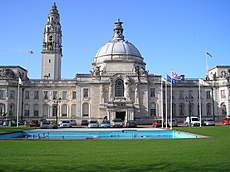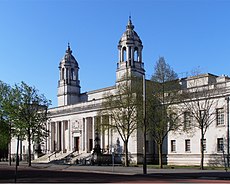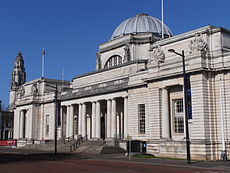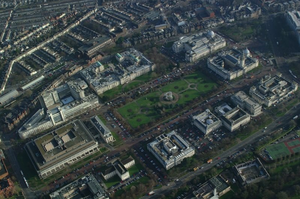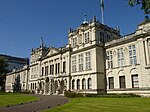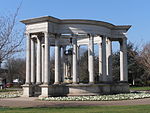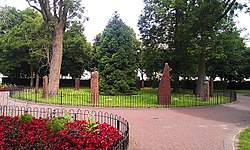Cathays Park
Cathays Park is an area in the centre of Cardiff, the great city of Glamorgan, which forms a civic centre with a central park containing several prominent early 20th century civic and academic buildings and memorials. The park is known as Alexandra Gardens.
Cathays park includes Edwardian buildings such as the Temple of Peace, City Hall, the National Museum and Gallery of Wales and several buildings belonging to the Cardiff University campus. It also includes Cardiff Crown Court, and the more modern Cardiff Central police station. The Pevsner architectural guide to Glamorgan judges Cathays Park to be "the finest civic centre in the British Isles".[1]
- Location map: 51°29’12"N, 3°10’49"W
History
Cathays Park was formerly part of the grounds of Cardiff Castle, which belonged to the Marquesses of Bute. The present-day character of the area owes much to successive Marquesses, especially John Crichton-Stuart, 3rd Marquess of Bute an extremely successful and wealthy businessman. The Crichton-Stuarts acquired much of the lands in Cathays through investment and by inheritance through a marriage to Charlotte Windsor in 1766.
The idea of acquiring the Cathays House park as an open public space was raised in 1858 and again in 1875. In 1887 it was suggested the park could commemorate Queen Victoria's Golden Jubilee. Negotiations did not begin until 1892, when Lord Bute agreed to sell 38 acres for £120,000.[2] The idea of relocating the Town Hall to the park was controversial, but it was also proposed to locate a new University College building there.
On 14 December 1898, the Cardiff corporation bought the entire 59 acres of land for £161,000 from the Marquess of Bute.[2] As part of the sale, the 3rd Marquis of Bute placed strict conditions on how the land was to be developed. The area was to be used for civic, cultural and educational purposes, and the avenues were to be preserved.
A six month Cardiff Fine Arts, Industrial and Maritime Exhibition which included specially constructed boating lake, a wooden cycling track and an electric railway was held in 1896.[3]
In 1897 a competition was held for a complex comprising Law Courts and a Town Hall, with Alfred Waterhouse, architect of the Natural History Museum in London, as judge. The winners were the firm of Lanchester, Stewart and Rickards, who would later go on to design the Methodist Central Hall in Westminster. These were the first two buildings of the ensemble and have an almost uniform façade treatment. The east and west pavilions of both façades are identical in design, except for the attic storeys, which are decorated with allegorical sculptural groups. On the Crown Court these are Science and Industry, sculpted by Donald McGill, and Commerce and Industry, by Paul Raphael Montford, while on the City Hall are Music and Poetry by Paul Montford and Unity and Patriotism by Henry Poole.
The third site in this complex went empty until 1910, when the competition for a National Museum of Wales was won by the architects Smith and Brewer. The design parts from the Edwardian Baroque of the Law Courts and City Hall and is more akin to American Beaux-Arts architecture, particularly in the entrance hall where a similarity to McKim, Mead and White's later Metropolitan Museum of Art in New York City has been noted. The Museum site was not bounded to the north by an avenue so there were scarcely any limits on the depth of the building; the 1910 plan was almost twice as deep as it was broad. The First World War, however, ensured that progress on the building was very slow. By 1927 part of the East range, with the lecture theatre funded by William Reardon Smith, was complete. Further extensions came only in the 1960s and '90s; these remained faithful to the original design on the exterior (and included sculpture by Dhruva Mistry) but are of a neutral character on the inside.
Due to presence of the then Welsh Office building, by the 1990s 'Cathays Park' became a metonym for that Government department.
Buildings
| Buildings and structures | Listed building status |
|---|---|
| Biosciences and Tower Building | No listing |
| Bute Building | Grade II |
| Cardiff Central Police Station | No listing |
| Cardiff Crown Court | Grade I |
| Cardiff Law School | No listing |
| Cardiff University | Grade II* |
| City Hall | Grade I |
| Crown Building of the Welsh Government | Grade II |
| Glamorgan Building (former Glamorgan County Council building) | Grade I |
| Hut in Gorsedd Gardens | Grade II |
| National Museum and Gallery of Wales | Grade I |
| Public conveniences on Museum Avenue | Grade II |
| Redwood Building (Welsh School of Pharmacy) | No listing |
| Temple of Peace | Grade II |
| University of Wales, Registry | Grade II |
| Welsh National War Memorial | Grade II* |
Gardens
In addition to the large lawn in front of the City Hall, Cathays Park includes three formal gardens. All of the spaces are within conservation areas and many of the surrounding buildings are listed. The open spaces are very important to the image of the city. Several important buildings overlook these well kept spaces. Each of the three gardens has its own very different character and each retains its original layout. Given their location, large numbers of people visit and pass through and they are popular venues for lunchtime breaks.
- Alexandra Gardens: Named after Alexandra of Denmark, the Queen consort of Edward VII, Alexandra Gardens is located at the heart of the civic centre. It consists of six acres of beautifully maintained flower beds and grass, with the War Memorial standing at its centre.
- Gorsedd Gardens: Situated in front of the National Museum, this garden has as its centrepiece a stone circle constructed in 1899, when the Royal National Eisteddfod of Wales was held in Cardiff. The garden's name refers to the Gorsedd of Bards, the ceremonial order that governs the Eisteddfod. The landscaped garden has statues of subjects including David Lloyd George and Lord Ninian Crichton-Stuart.
- Overlooking Gorsedd Gardens, though not strictly part of the Cathays Park complex, is Park House (or McConnochie House), an influential work by the Neo-Gothic architect William Burges.
- Friary Gardens: Constructed in honour of the 3rd Marquess of Bute, it contains topiary, a statue standing upon a stone pedestal blazoned with a coat of arms, and clipped hedges around the perimeter.
Statues
| Statue | Listed structure status |
|---|---|
| John Crichton-Stuart, 3rd Marquess of Bute | Grade II |
| John Cory | Grade II |
| Lord Aberdare | Grade II |
| Lord Ninian Crichton-Stuart | Grade II |
| David Lloyd George | Grade II |
| Godfrey Charles Morgan, 1st Viscount Tredegar | Grade II |
| Judge Gwilym Willams of Miskin | Grade II |
| South African War Memorial (also known as the Boer War Memorial) | Grade II* |
Memorial stones
Cathays Park also has memorials stones dedicated to:
- Raoul Wallenberg, a Swedish diplomat who saved the lives of up to 100,000 Hungarian Jews by issuing them with Swedish passports enabling them to flee the Nazis. This stone was unveiled on 24 November 1985.
- The servicemen of Cardiff who served in the Falklands War.
- Those who fought in the International Brigade during the Spanish Civil War, which was unveiled in October 1992.
- The charity Kidney Wales Foundation, gifted a memorial, called The Gift of Life Stone, to those who donated their organs and tissues to save others. It is located in Alexandra Gardens and stands 5 feet tall. It was unveiled on 26 October 2007.[4]
Outside links
| ("Wikimedia Commons" has material about Cathays Park) |
References
- ↑ Nikolaus Pevsner: The Buildings of Wales: Glamorgan, 1995 Penguin Books ISBN 978-0-300-09629-3page 220
- ↑ 2.0 2.1 Prof. William Rees (1969), "The Reformed Borough, 1836-1914", Cardiff - A History Of The City, The Corporation of the City of Cardiff, pp. 336-337
- ↑ "Cardiff Remembered: When tigers, lions and crocodiles patrolled the city at 1896 exhibition - Wales Online". https://www.walesonline.co.uk/lifestyle/nostalgia/cardiff-remembered-tigers-lions-crocodiles-8540588. Retrieved 3 April 2019.
- ↑ "Gift of Life Stone". Kidney Wales Foundation. https://www.kidneywales.cymru/news/2007/10/04/gift-of-life-stone-3/. Retrieved 2017-07-17.
- Morley, Ian: 'Representing a City and Nation: Wales's Matchless Civic Centre' (The Welsh History Review; volume 24, issue 3, pages 56–81
